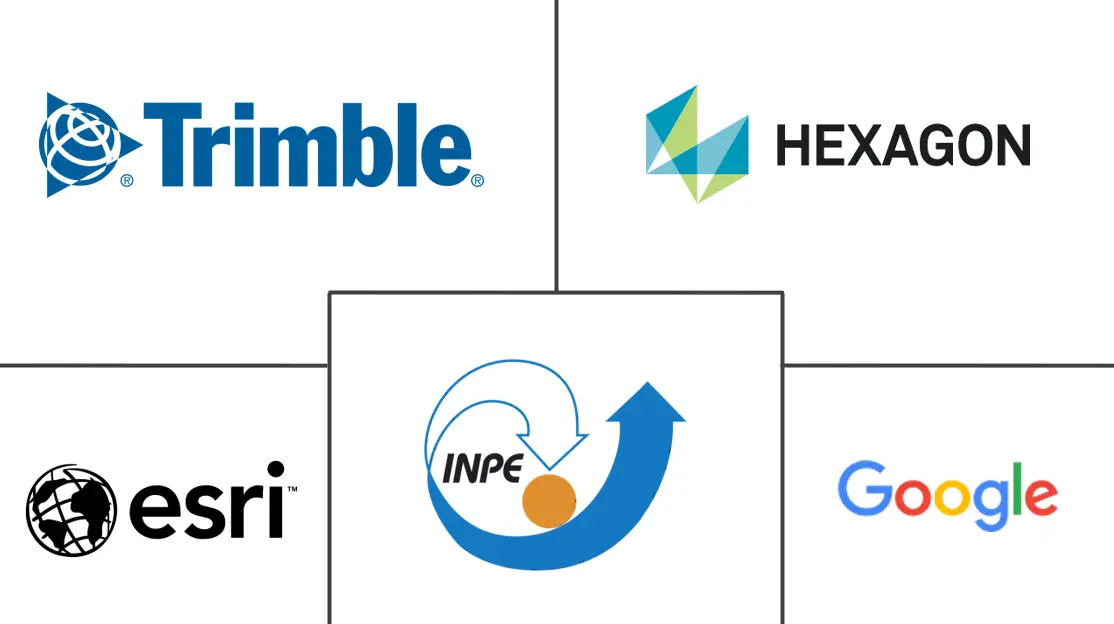Brazil Geospatial Analytics Market Size and Share
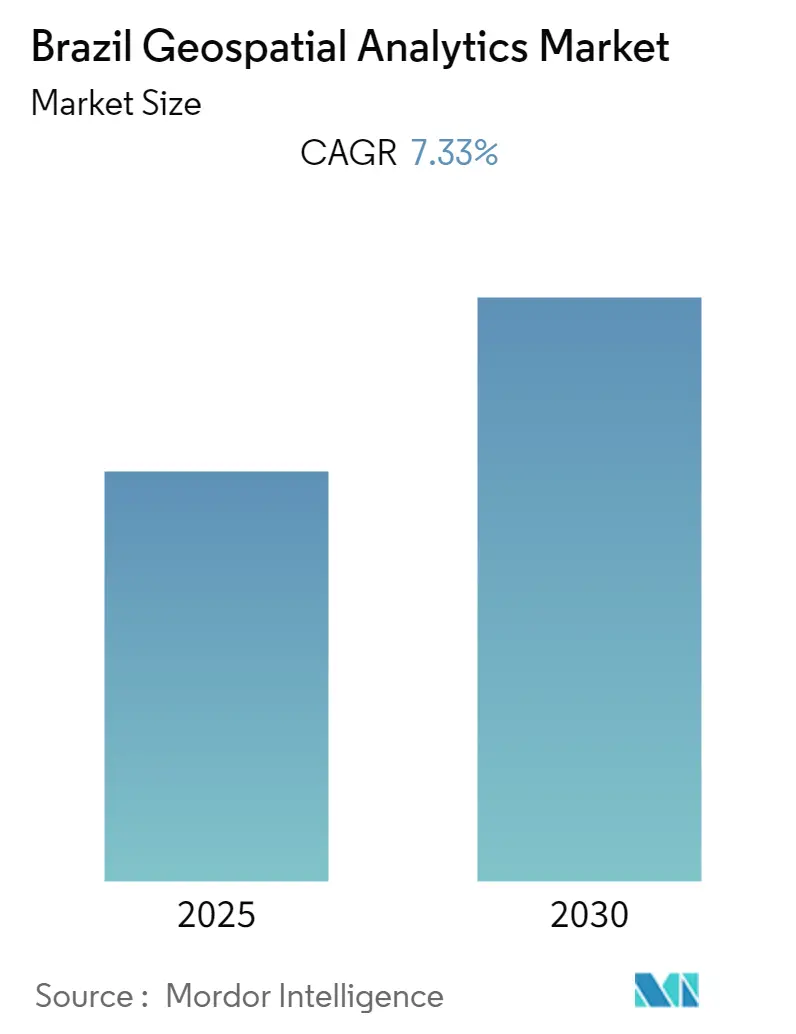
Brazil Geospatial Analytics Market Analysis by Mordor Intelligence
The Brazil Geospatial Analytics Market is expected to register a CAGR of 7.33% during the forecast period.
The growing demand for location-based services (LBS) is driving the need for accurate and real-time geospatial data. Retail, logistics, and tourism industries are leveraging geospatial analytics to optimize operations, improve customer experiences, and gain competitive advantages.
- Brazil is one of the largest agricultural producers globally, and geospatial analytics is crucial in optimizing agricultural practices. It helps farmers and agribusinesses make data-driven decisions, improve crop productivity, optimize resource allocation, and reduce environmental impacts.
- In addition, Brazil is known for its rich and diverse ecosystems, including the Amazon rainforest. Geospatial analytics could be extensively used for environmental monitoring, conservation, and resource management. It enables the assessment of deforestation, biodiversity, land use changes, and water resources. Geospatial analytics might also support sustainable environmental management practices and aids decision-making for effectively preserving and managing natural resources.
- The Brazilian government has been actively promoting the adoption of geospatial analytics across various sectors. Initiatives such as the National Plan for Geospatial Information (PING) and the National Geospatial Infrastructure (INDE) aim to enhance the availability, quality, and interoperability of geospatial data. These government-led efforts have created a favorable environment for geospatial analytics adoption and implementation.
- In addition, the integration of geospatial analytics with emerging technologies, such as big data, the Internet of Things (IoT), artificial intelligence (AI), and machine learning, is driving market growth. These technologies enable the processing, analysis, and visualization of vast amounts of geospatial data, leading to real-time monitoring, predictive analytics, and intelligent decision-making.
- Geospatial analytics relies on robust infrastructure, including reliable internet connectivity, satellite imagery, and remote sensing capabilities. In some areas of Brazil, there may be limitations in infrastructure development, hindering the seamless collection and transmission of geospatial data. Insufficient infrastructure can act as a constraint on the market's growth potential.
- Geospatial analytics aided in identifying high-risk areas and optimizing resource allocation for testing, healthcare facilities, and vaccination campaigns. At the same time, the economic downturn caused by the pandemic had an adverse impact on various industries, including the geospatial analytics sector. Budget constraints and financial uncertainties among organizations may slowed down investment and adoption of geospatial analytics solutions.
Brazil Geospatial Analytics Market Trends and Insights
Company Initiatives Coupled with Government Support to Drive the Market Growth
- Companies operating in the geospatial analytics sector often collaborate with government agencies, research institutions, and industry stakeholders to develop innovative solutions. These partnerships might facilitate knowledge sharing, resource pooling, and the exchange of best practices. Collaborative efforts would promote the advancement of geospatial analytics technologies, enabling companies to deliver more robust and tailored solutions to meet market demands.
- Moreover, companies involved in geospatial analytics would recognize the importance of continuous research and development to enhance their offerings. With government support, these companies could invest in cutting-edge technologies, explore new data sources, and improve analytical capabilities. This might foster innovation, enable advanced algorithms' development, and drive the market forward.
- Moreover, according to data from the Ministry of Communications, Government of Brazil, in 2022, the satellites in commercial operation in Brazil are majorly operated by Intelsat License LLC with around 11 satellites, followed by Embratel TVSAT Telecommunications S.A. with six satellite count. The presence of satellite operators like Intelsat License LLC and Embratel TVSAT Telecommunications S.A. indicates the availability of satellite data, which can support geospatial analytics initiatives in Brazil.
- In addition, governments play a crucial role in establishing policies and standards that govern the use and exchange of geospatial data. Governments may promote data sharing, interoperability, and standardization by creating a favorable regulatory environment such as Deforestation. Clear policies and standards would encourage companies to develop compatible and scalable geospatial analytics solutions, fostering market growth and facilitating seamless integration with other sectors.
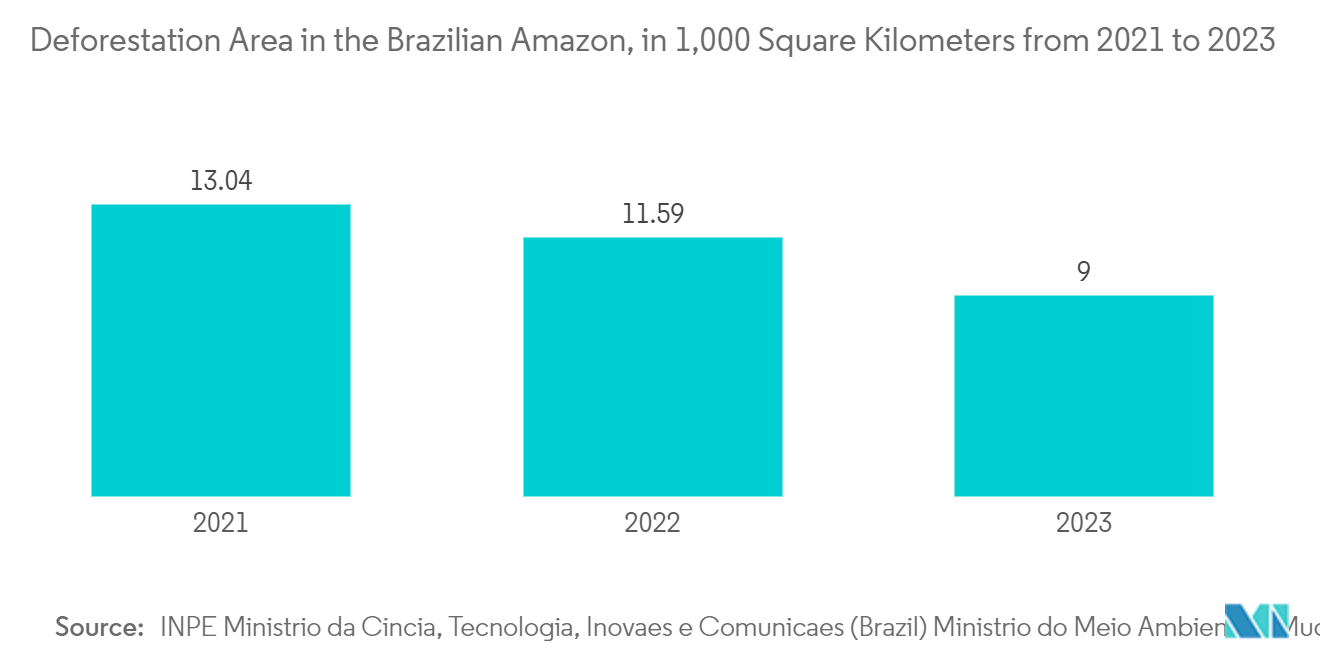
Geovisualization Segment to Hold a Significant Market Share
- Geovisualization refers to representing and visualizing geospatial data through interactive maps, charts, graphs, and other visual tools. It plays a crucial role in interpreting complex spatial information and communicating insights effectively.
- Geovisualization techniques could allow for the effective visualization of geospatial data, making it easier for users to comprehend and analyze complex information. It enables stakeholders to visually explore and interact with spatial data and uncover patterns, trends, and relationships that may not be immediately apparent in raw data.
- Moreover, geo-visualization could offer interactive and dynamic features that allow users to manipulate and explore spatial data in real time. Users can zoom in, zoom out, pan, filter, and interact with the visual representations to gain deeper insights. This interactivity could foster a better understanding of spatial relationships and facilitates data exploration and analysis.
- According to data from the Ministry of Communications, Government of Brazil, geostationary satellites accounted for most of the satellites in commercial operation in Brazil in 2022, with about 43 satellites operated by 24 operators. The number of non-geostationary satellites was seven, with eight operators. This data reflects the country's significant presence and activity of geostationary satellite operators used for various visualization applications, such as mapping and monitoring, earth observation, communication, etc.
- Further, with the growing demand for data visualization, decision support, collaboration, and effective communication, the geo-visualization segment is expected to hold a significant market share in the Brazil geospatial analytics market. As organizations and industries increasingly recognize the value of geo-visualization in harnessing the power of geospatial data, the demand for advanced geo-visualization tools and techniques is likely to grow, driving market expansion and innovation in Brazil.
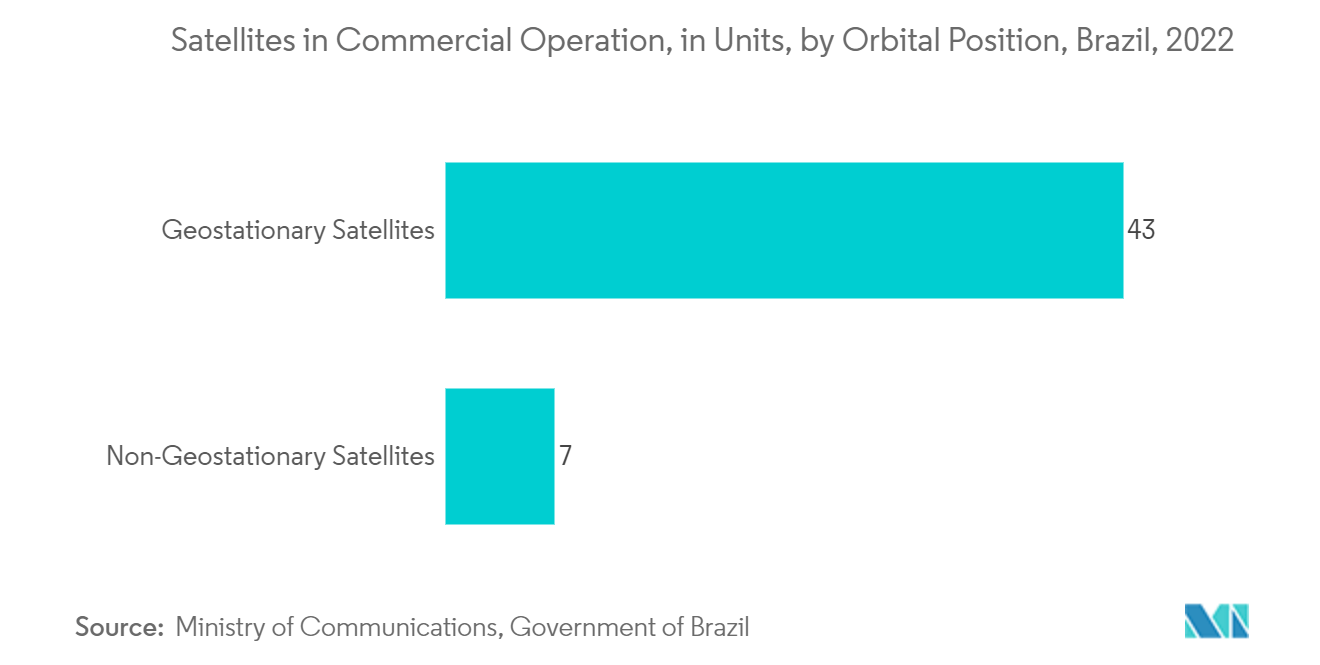
Competitive Landscape
The Brazil geospatial analytics market is expected to be fragmented in nature. The Brazil geospatial analytics market is expected to be competitive, with multiple companies aiming for market share. Key players such as Esri, Google, Hexagon AB, and Trimble have a significant presence, but numerous local and regional players compete for market share.
In March 2023, INFLOR and the Brazilian ecological restoration business re.green teamed together to jointly protect and restore the earth. The companies would work together through a partnership with re.green to maintain native forests and restore damaged regions in Brazil to support the creation of a more environmentally friendly world. The cooperation would launch in December with the introduction of the INFLOR Forest Registration, GIS, and Forestry modules.
In August 2022, the Massachusetts Institute of Technology's (MIT) Senseable City Lab, renowned for its research on cities and advanced technology, undertook a groundbreaking project known as Favelas 4D. The objective of this project was to map the largest favela in Brazil, Rocinha, using cutting-edge 3D technology. To accomplish this task, the researchers employed a sophisticated 3D laser scanning technique called LiDAR, which stands for Light Detection and Ranging. This technology allowed them to create a highly detailed virtual representation of Rocinha, capturing its intricate layout and structures in unprecedented detail.
Brazil Geospatial Analytics Industry Leaders
-
Esri Global, Inc.
-
Google LLC (Alphabet Inc.)
-
Hexagon AB
-
Trimble Inc.
-
INPE (National Institute for Space Research)
- *Disclaimer: Major Players sorted in no particular order
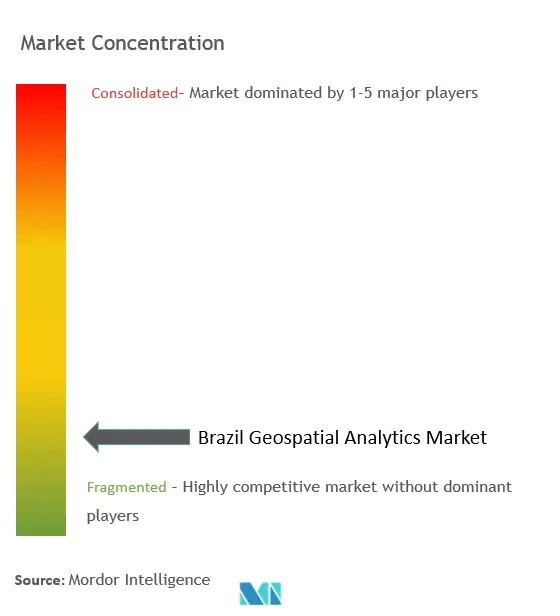
Recent Industry Developments
- June 2023: Researchers from Brazil's National Space Research Institute (INPE) combined hydrodynamic models with models that forecast urban growth and changes in land use to develop a methodology that can identify flood-prone areas of cities, particularly those that are vulnerable to the effects of very heavy rainfall. The organization employed deep learning with extremely high-resolution spatial imagery.
- June 2023: PXGEO, a leading marine geophysical company, made an exciting announcement regarding its recent contract with Petrobras. The renowned Brazilian energy corporation has commissioned PXGEO to conduct a cutting-edge 3D ocean bottom node (OBN) study in the Campos Basin, Brazil. This project marks a significant step forward in the exploration and understanding of the region's offshore resources. According to PXGEO, the comprehensive survey is set to take place over an extensive period of ten months, delving deep into the ocean at an impressive depth of 2,300 meters.
Brazil Geospatial Analytics Market Report Scope
Geospatial analytics is the process of acquiring, manipulating, and displaying imagery and data from the geographic information system (GIS), such as satellite photos and GPS data. The specific identifiers of a street address and a zip code are used in geospatial data analytics. They are used to create geographic models and data visualizations for more accurate trends modeling and forecasting.
The Brazil geospatial analytics market is segmented by type (surface analysis, network analysis, and geovisualization), by end-user vertical (agriculture, utility and communication, defense and intelligence, government, mining and natural resources, automotive and transportation, healthcare, real estate and construction, and other end-user verticals).
The market sizes and forecasts are provided in terms of value in USD for all the above segments.
| Surface Analysis |
| Network Analysis |
| Geovisualization |
| Agriculture |
| Utility and Communication |
| Defense and Intelligence |
| Government |
| Mining and Natural Resources |
| Automotive and Transportation |
| Healthcare |
| Real Estate and Construction |
| Other End-User Verticals |
| By Type | Surface Analysis |
| Network Analysis | |
| Geovisualization | |
| By End-User Vertical | Agriculture |
| Utility and Communication | |
| Defense and Intelligence | |
| Government | |
| Mining and Natural Resources | |
| Automotive and Transportation | |
| Healthcare | |
| Real Estate and Construction | |
| Other End-User Verticals |
Key Questions Answered in the Report
What is the current Brazil Geospatial Analytics Market size?
The Brazil Geospatial Analytics Market is projected to register a CAGR of 7.33% during the forecast period (2025-2030)
Who are the key players in Brazil Geospatial Analytics Market?
Esri Global, Inc., Google LLC (Alphabet Inc.), Hexagon AB, Trimble Inc. and INPE (National Institute for Space Research) are the major companies operating in the Brazil Geospatial Analytics Market.
What years does this Brazil Geospatial Analytics Market cover?
The report covers the Brazil Geospatial Analytics Market historical market size for years: 2019, 2020, 2021, 2022, 2023 and 2024. The report also forecasts the Brazil Geospatial Analytics Market size for years: 2025, 2026, 2027, 2028, 2029 and 2030.
Page last updated on:
Brazil Geospatial Analytics Market Report
Statistics for the 2025 Brazil Geospatial Analytics market share, size and revenue growth rate, created by Mordor Intelligence™ Industry Reports. Brazil Geospatial Analytics analysis includes a market forecast outlook for 2025 to 2030 and historical overview. Get a sample of this industry analysis as a free report PDF download.
